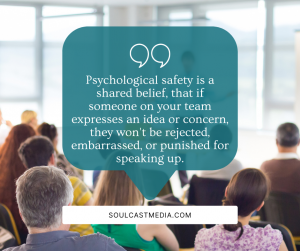Tools Of An Effective Manager
Part of being a great manager is performing and hitting our goals and numbers. We will need other people and our team’s help to get there. This is why creating a healthy team dynamic is very important.
It is important to understand psychological safety.
Psychological safety is a shared belief, that if someone on our team expresses an idea or concern, they won’t be rejected, embarrassed, or punished for speaking up.
According to a recent study, psychologically safe workplaces experience 50% more productivity.
Creating this safe dynamic starts with us as managers. Below are three ways we can maintain psychological safety in the workplace.
1. Showcase Vulnerability
To promote a psychologically safe environment, we, as managers, may need to showcase vulnerability. This means, instead of leading our team from a distance, we are willing to share we understand their challenges, because we’ve experienced them too.
Consider the following
- Shared Experiences – As humans, we better connect with others who have shared experiences. We can showcase vulnerability with our team by sharing an experience relating to what our team is going through. For example, if our team worked really hard to land a client, but the client went with another firm, we can think back to a time early in our careers when we experienced the same thing. We can share this experience with our team. Let them know they aren’t alone, and that we understand their frustrations.
- Apologize When We’re Wrong – Being a manager doesn’t mean we won’t ever make a mistake. To create a psychologically safe environment, we need to apologize when we are wrong. For example, let’s say we discovered what we thought was an error one of your team members made. We point out the error to the team member. However, the team member responded by showing us it wasn’t an error at all, and we were looking at it the wrong way. We should acknowledge our mistake and apologize. If we don’t, the team member may assume we still think they made a mistake which can be very frustrating.
- Admit You Don’t Know – We may manage a large team, but it doesn’t necessarily mean we know everything. Admitting we don’t know something can showcase vulnerability. For example, if a team member asks us a question we don’t know the answer to, we should admit we don’t know, rather than try to come up with an answer. Our team will have more confidence in our answers because they know we will tell them when we aren’t sure.
Showcasing vulnerability will help us promote a psychologically safe environment.
2. Engage With Our Team
As managers, we want our team to feel comfortable coming to us with any questions or concerns. To do this, we must be proactive in our communications to ensure our team feels this way.
Consider the following
- Positive Body Language – We must practice positive body language when engaging with our team. For example, when our team member is speaking, we can nod our heads, so they see we are present and acknowledging what they are saying. We can also paraphrase what they’ve just said to show we were listening. Positive body language will help us create this safe dynamic.
- Get To Know Them – Another way to engage with our team and create a psychologically safe dynamic is to get to know our team. This means asking them questions unrelated to work. For example, before our meeting begins, we can set aside a few minutes to ask our team about their weekend or favorite movies. When everyone on our team gets to know each other as people, our team will feel more comfortable coming to us with questions or concerns.

- Be Consistent – If we want our team to feel comfortable coming to us with questions or concerns, we need to be consistent. This means ensuring we respond promptly and are consistent in the way we handle good and bad news. For example, if our team sends us an email about an issue with the supplier, and we sit on the email for a few days, the team may not let us know about future issues because we don’t respond. On the other hand, if they send us an email about an issue, we overreact one time, but underact the next time, they may find this inconsistency unstable. They won’t know what to expect, which promotes a dynamic of fear rather than safety.
Engaging with our team in a positive, consistent way will help foster a safe dynamic and help our team work at their highest level.
3. Build Trust
To create a psychologically safe dynamic, we need to build trust. This means creating an environment where our team feels like they won’t get punished for making a small mistake.
Consider the following:
- Approach – The way we approach our team members when they’ve made a mistake is critical. For example, pointing out a mistake and saying, “Why did you do this?” Or saying, “Yikes! This is embarrassing.” We will put the other person on the defensive, making them more afraid to admit a mistake in the future. Instead, consider handling errors less reactively. For example, we can say, “We noticed XYZ, and we know you didn’t mean to do this incorrectly, let’s take care of it and make sure to double-check next time.” The approach we take will impact our safe dynamic.

- Tone of Voice – Our tone of voice can dramatically affect how our team members interpret what we say. For example, our team members may find this condescending if we use a down tone when asking a question. We need to be mindful of our tone of voice and how others may interpret it.
Fostering a safe dynamic requires us to build trust with our team so they can face their mistakes without fear.
Creating a place and an atmosphere where everyone feels safe to express and share their ideas is one of the most powerful ways to get the conversation flowing.
__
Whenever you’re ready, there are 3 ways we can help you:
- Discover your communications style so you know where to start. Over 4,000 people have found theirs here.
- Attend our monthly communication workshop to build communications confidence (new topics: public speaking, advocating for yourself, building credibility, etc) here.
- Get your brand in front of 43k+ people by sponsoring our newsletter or Soulcast Media | LIVE LinkedIn events [contact: hello@soulcastmedia.com]











